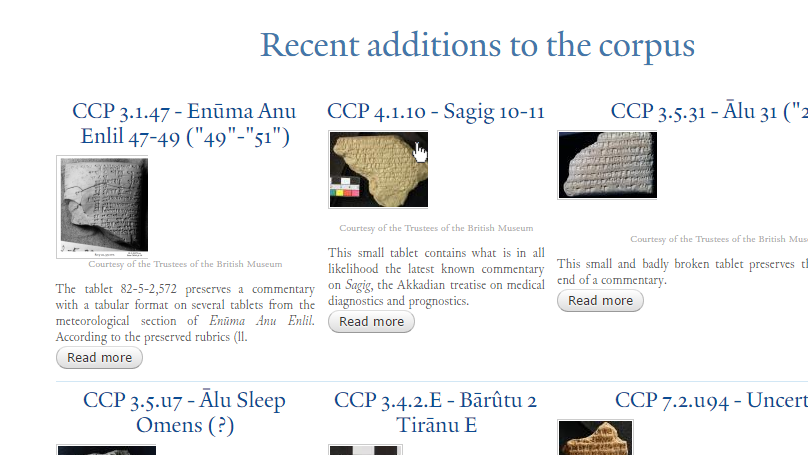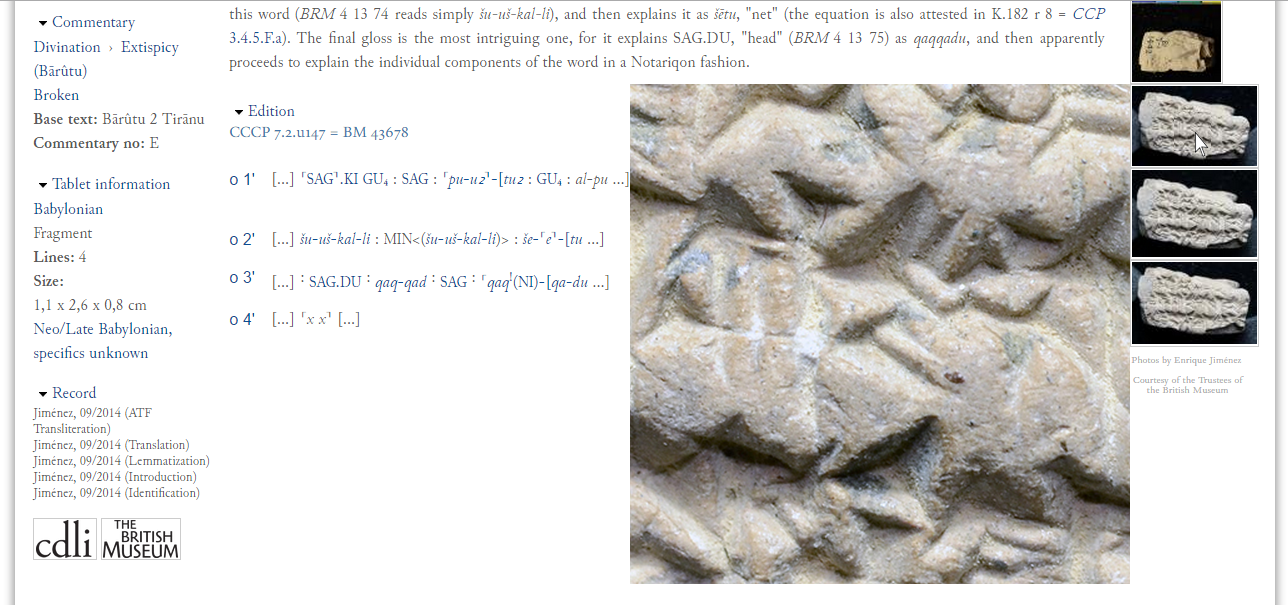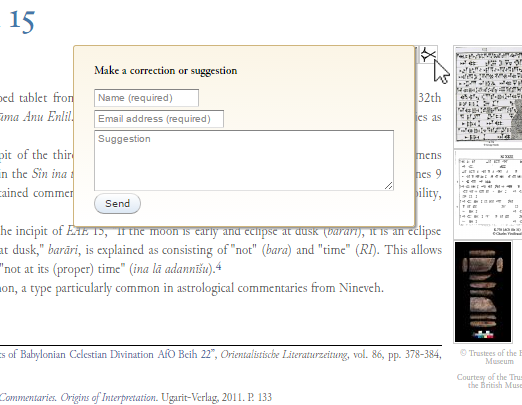There are several ways to access the Cuneiform Commentaries Project editions. The simplest way is to click on any item from the list of “Recent additions to the corpus,” on the home page. This section lists the most recently edited commentaries.

The complete catalog can be accessed by clicking on the tab “Catalog of Commentaries.” The user can see the complete catalog by clicking on the words “Catalog of Commentaries,” or a partial catalog by selecting any of the genres or subgenres from the drop-down menu. Both actions will produce a list of all commentary tablets, which can then be filtered by a multiplicity of criteria, such as the tablet’s museum number, the place of publication, or its findspot.

All the commentaries in the Cuneiform Commentaries Project have been lemmatized using the tools developed by Steve Tinney for Oracc. Thanks to them, glossaries of the corpus are compiled periodically. These glossaries can be accessed by clicking on the tab “Glossary,” and by then choosing between “Akkadian,” “Sumerian,” or “Personal Nouns” in the drop-down menu. The glossaries are embedded directly from the project’s Oracc site: clicking on any of the lemmata will generate a list of its appearances in the corpus of already edited commentaries in a new window, as in the image below.

It is also possible to search the corpus for written strings of signs (such as ger-ra-a-ni) without using the glossary. If you want to do that, please use the project’s mirror on Oracc, the Cuneiform Commentaries Project on Oracc.
.png)
***
Each tablet’s record contains several fields describing the tablet and the text on it. The fields are grouped under various categories, such as “Commentary,” “Tablet,” “Colophon,” or “Bibliography.” If you wish to display only some of these fields, you can hide those that you do not need by clicking on the group’s name. This feature is useful, for instance, for users who want to see the edition but not the introduction: hiding the “Introduction” section will bring the edition closer to the top of the page and to the photos. In the image below, the field groups that can be “collapsed” are marked in red.

In each record small photographs of the tablet are displayed on the right hand side of the page using the Drupal module Cloud Zoom: when hovering the mouse over the thumbnail, the real image is retrieved in a zoom panel that appears next to the mouse. This means that only the area of the tablet that the user wishes to consult is loaded, which in turn enables large numbers of images to be loaded instantaneously. Passages can thus be collated in an efficient manner.

The full image can also be seen in an internal window (a “Colorbox”) by clicking on each thumb. The time it takes to load, however, depends on the speed of the user’s internet connection. Additionally, it is possible to open the full image in a different tab by clicking on the icon shown in the image below.1

***
The Cuneiform Commentaries Project website borrows the editions live from the project’s Oracc portal (Cuneiform Commentaries Project on Oracc (CCPo)), from where they are embedded directly in the project’s website with minimal changes.2 Oracc’s glossaries can be accessed by clicking on each word of the transliteration.
***
An exhaustive bibliography of each tablet is displayed to the left hand side of each record. The references are shown in the format: Author, Year. The complete reference can be retrieved by hovering the mouse over a citation. The first set of bibliographical references, under the title “Publication,” lists articles and monographs that contain editions of the texts. The second set, under the title “Bibliography,” lists places where the tablet is discussed, but not edited. In either case, the Cuneiform Commentaries Project provides links to the article’s or book’s DOI, whenever they are available, as well as links to electronic copies of articles in JSTOR, Propylaeum, and Academia.edu. The electronic copy can be accessed by clicking on the article’s title as it appears in the tooltip.

The complete bibliography of all references cited on this website is accessible by clicking on the tab Bibliography. Additionally, a short list of the most important publications on Mesopotamian commentaries can be accessed by clicking on “Basic Bibliography,” in the drop-down menu.
***
To access the tablet’s record in CDLI, Oracc, and the British Museum electronic catalog, click on the small icon at the bottom of the left column, as in the image below. The record will open in a separate window.

Text editions with several manuscripts can be displayed as (1) composite editions, (2) score editions, or (3) as editions of individual manuscripts. If the text is displayed as a composite edition, a score transliteration of the manuscripts for one line can be displayed by clicking on the line number.

Users are kindly asked to provide the editors with their feedback, or to report any error they may find. An easy way to do that is by using the form provided in each record. When hovering over the symbol ![]() , which appears on each page beside the author’s name, a balloon-style tooltip will appear with the title “Make a correction or suggestion.” The user is required to fill out the fields “Name,” “Email address,” and “Suggestion.”
, which appears on each page beside the author’s name, a balloon-style tooltip will appear with the title “Make a correction or suggestion.” The user is required to fill out the fields “Name,” “Email address,” and “Suggestion.”

For information on how to cite this page and on licensing, please see the Citation Guidelines.
- 1. This feature is courtesy of Vincent Massaro, Senior Web Engineer, Yale ITS.
- 2. The only differences between Oracc’s and CCP’s conventions are the CCP’s use of the pilcrow (¶) or paragraph mark, instead of Oracc’s asterisk (*), to represent the diš-sign; and CCP’s use of small-caps instead of all caps for logograms and sign names.